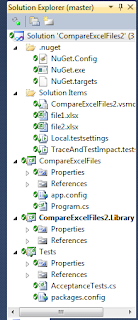Math is a game
Math is a game, an arbitrary set of symbols and rules. The weird part, the part that always surprises me, is that it's relevant to the real world.
Here's an example: we'll start with just two symbols, Yin and Yang. (Replace those with black and white, circle and square, X and Y… whichever two symbols you prefer.) What can we do with them?
Well, the simplest thing we can do is transform one into the other:
Yin → Yang; Yang → Yin
We'll call this transformation "mirroring" and denote it with the letter "M".
What about combining two symbols? We have a number of possibilities:
A) Yin, Yang → Yin; Yang, Yin → Yin; Yin, Yin → Yin; Yang, Yang → Yin
This is rather boring… no matter what we start with, we obtain an Yin symbol. Nevertheless, let's continue.
B) The opposite of A: Yin, Yang → Yang; Yang, Yin → Yang; Yin, Yin → Yang; Yang, Yang → Yang. Still boring.
C) Yin, Yang → Yin; Yang, Yin → Yin; Yin, Yin → Yin; Yang, Yang → Yang
Ok, so this is a bit more interesting: this combination still overwhelmingly favors the Yin symbol, but at least once in a while we get back an Yang. For completion, we'll also write down its opposite:
D) Yin, Yang → Yang; Yang, Yin → Yang; Yin, Yin → Yang; Yang, Yang → Yin
The last two combinations give us an equal distribution of the results:
E) Yin, Yang → Yin; Yang, Yin → Yin; Yin, Yin → Yang; Yang, Yang → Yang
F) Yin, Yang → Yang; Yang, Yin → Yang; Yin, Yin → Yin; Yang, Yang → Yin
I'll summarize the A..F combinations in a table:
| 1st | 2nd | A | B | C | D | E | F |
| Yin | Yang | Yin | Yang | Yin | Yang | Yin | Yang |
| Yang | Yin | Yin | Yang | Yin | Yang | Yin | Yang |
| Yin | Yin | Yin | Yang | Yin | Yang | Yang | Yin |
| Yang | Yang | Yin | Yang | Yang | Yin | Yang | Yin |
So, what was the point of all this? In itself, nothing much. We can imagine that two kids might alternate playing this game, where one of them writes symbols and the other one combines them to obtain the result, and the one with the most correct results wins. It doesn't really matter: the interesting part is that we just re-invented Boolean logic. The Yin and Yang symbols are 0 and 1 (or true and false) and the transformations are the well-known Boolean operators: and, or, xor, equ and finally not for what we called "mirroring" (I've ignored the "boring" A and B). Given that Boolean logic is used by all computers, this is quite amazing - what looked like rather pointless playing with two symbols picked at random proved to be hugely important.


Comments